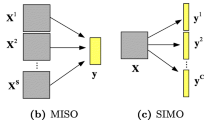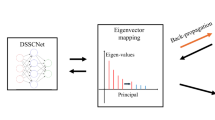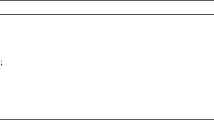Abstract
As a powerful data representation framework, dictionary learning has emerged in many domains, including machine learning, signal processing, and statistics. Most existing dictionary learning methods use the ℓ0 or ℓ1 norm as regularization to promote sparsity, which neglects the redundant information in dictionary. In this paper, a class of joint sparse regularization is introduced to dictionary learning, leading to a compact dictionary. Unlike previous works which obtain sparse representations independently, we consider all representations in dictionary simultaneously. An efficient iterative solver based on ConCave-Convex Procedure (CCCP) framework and Lagrangian dual is developed to tackle the resulting model. Further, based on the dictionary learning with joint sparse regularization, we consider the multi-layer structure, which can extract the more abstract representation of data. Numerical experiments are conducted on several publicly available datasets. The experimental results demonstrate the effectiveness of joint sparse regularization for dictionary learning.





Similar content being viewed by others
References
Aharon M, Elad M. Bruckstein, a.: k-svd: an algorithm for designing overcomplete dictionaries for sparse representation. IEEE Trans Signal Process 2006;54(11):4311–22.
Argyriou A, Evgeniou T, Pontil M. Multi-task feature learning. Advances in neural information processing systems; 2007. p. 41–8.
Bengio Y, Lamblin P, Popovici D, Larochelle H. Greedy layer-wise training of deep networks. Advances in neural information processing systems; 2007. p. 153–60.
Boyd S, Parikh N, Chu E, Peleato B, Eckstein J. Distributed optimization and statistical learning via the alternating direction method of multipliers. Foundations and TrendsⓇ, in Machine Learning 2011;3(1):1–122.
Chen SB, Xin Y, Luo B. Action-based pedestrian identification via hierarchical matching pursuit and order preserving sparse coding. Cogn Comput 2016;8(5):797–805.
Chen Y, Nasrabadi NM, Tran TD. Hyperspectral image classification via kernel sparse representation. IEEE Trans Geosci Remote Sens 2013;51(1):217–31.
Davis G, Mallat S, Avellaneda M. Adaptive greedy approximations. Constr Approx 1997;13(1):57–98.
Fan J, Li R. Variable selection via nonconcave penalized likelihood and its oracle properties. J Am Stat Assoc 2001;96(456):1348–60.
Gui J, Sun Z, Ji S, Tao D, Tan T. Feature selection based on structured sparsity: a comprehensive study. IEEE Trans Neural Netw Learn Syst 2017;28(7):1490–1507.
Hinton GE, Osindero S, Teh YW. A fast learning algorithm for deep belief nets. Neural Comput 2006; 18(7):1527–54.
Huang K, Ying Y, Campbell C. Gsml: a unified framework for sparse metric learning. 2009 ninth IEEE international conference on data mining. IEEE; 2009. p. 189–98.
Jiang W, Nie F, Huang H. Robust dictionary learning with capped l1-norm. IJCAI; 2015. p. 3590–96.
Jiang Z, Lin Z, Davis LS. Label consistent k-svd: learning a discriminative dictionary for recognition. IEEE Trans Pattern Anal Mach Intell 2013;35(11):2651–64.
Kasiviswanathan SP, Wang H, Banerjee A, Melville P. Online ℓ1 -dictionary learning with application to novel document detection. International conference on neural information processing systems; 2012. p. 2258–66.
Larochelle H, Erhan D, Courville A, Bergstra J, Bengio Y. An empirical evaluation of deep architectures on problems with many factors of variation. Proceedings of the 24th international conference on Machine learning. ACM; 2007. p. 473–80.
Lee H, Battle A, Raina R, Ng AY. Efficient sparse coding algorithms. Advances in neural information processing systems; 2007. p. 801–8.
Li X, Hu Z, Wang H. Combining non-negative matrix factorization and sparse coding for functional brain overlapping community detection. Cogn Comput. 2018;991–1005.
Li Z, Tang J. Weakly supervised deep matrix factorization for social image understanding. IEEE Trans Image Process 2017;26(1):276–88.
Liu H, Sun F. Discovery of topical objects from video: a structured dictionary learning approach. Cogn Comput 2016;8(3):519–28.
Liu H, Wang F, Zhang X, Sun F. Weakly-paired deep dictionary learning for cross-modal retrieval. Pattern Recogn Lett. 2018. https://doi.org/10.1016/j.patrec.2018.06.021.
Liu X, Wang L, Zhang J, Yin J, Liu H. Global and local structure preservation for feature selection. IEEE Transactions on Neural Networks and Learning Systems 2014;25(6):1083–95.
Liu X, Zhong G, Dong J. Natural image illuminant estimation via deep non-negative matrix factorisation. IET Image Process 2017;12(1):121–5.
Lou Y, Yin P, He Q, Xin J. Computing sparse representation in a highly coherent dictionary based on difference of l_1 and l_2. J Sci Comput 2015;64(1):178–96.
Mairal J, Bach F, Ponce J, Sapiro G. Online dictionary learning for sparse coding. Proceedings of the 26th annual international conference on machine learning. ACM; 2009. p. 689–96.
Mairal J, Ponce J, Sapiro G, Zisserman A, Bach FR. Supervised dictionary learning. Advances in neural information processing systems; 2009. p. 1033–40.
Majumdar A, Ward RK. Improved group sparse classifier. Pattern Recogn Lett 2010;31(13):1959–64.
Majumdar A, Ward RK. Robust classifiers for data reduced via random projections. IEEE Trans Syst Man Cybern B Cybern 2010;40(5):1359–71.
Manjani I, Tariyal S, Vatsa M, Singh R, Majumdar A. Detecting silicone mask-based presentation attack via deep dictionary learning. IEEE Trans Inf Forensics Secur 2017;12(7):1713–23.
Meinshausen N, Yu B. Lasso-type recovery of sparse representations for high-dimensional data. Ann Stat 2009;37:246–70.
Mukherjee S, Basu R, Seelamantula CS. ℓ1 -k-svd: a robust dictionary learning algorithm with simultaneous update. Signal Process 2016;123:42–52.
Nie F, Huang H, Cai X, Ding CH. Efficient and robust feature selection via joint ℓ2,1-norms minimization. Advances in neural information processing systems; 2010. p. 1813–21.
Schmidt MW, Murphy KP, Fung G, Rosales R. Structure learning in random fields for heart motion abnormality detection. CVPR; 2008. p. 2.
Sharma P, Abrol V, Sao AK. Deep-sparse-representation-based features for speech recognition. IEEE/ACM Transactions on Audio Speech & Language Processing 2017;25(11):2162–75.
Shen Y, Li J, Zhu Z, Cao W, Song Y. Image reconstruction algorithm from compressed sensing measurements by dictionary learning. Neurocomputing 2015;151:1153–62.
Shi Y, Miao J, Wang Z, Zhang P, Niu L. Feature selection with ℓ2,1 − 2 regularization. IEEE Trans Neural Netw Learn Syst 2018;29(10):4967–82.
Singhal V, Khurana P, Majumdar A. Class-wise deep dictionary learning. 2017 international joint conference on neural networks (IJCNN). IEEE; 2017. p. 1125–32.
Tariyal S, Majumdar A, Singh R, Vatsa M. Deep dictionary learning. IEEE Access 2016;4:10,096–109.
Tibshirani R. Regression shrinkage and selection via the lasso. J R Stat Soc Ser B Methodol 1996;58:267–88.
Trigeorgis G, Bousmalis K, Zafeiriou S, Schuller BW. A deep matrix factorization method for learning attribute representations. IEEE Trans Pattern Anal Mach Intell 2017;39(3):417–29.
Tuia D, Flamary R, Barlaud M. Nonconvex regularization in remote sensing. IEEE Trans Geosci Remote Sens 2016;54(11):6470–80.
Wang H, Nie F, Cai W, Huang H. Semi-supervised robust dictionary learning via efficient ℓ2,0+-norms minimization. Proceedings of the IEEE international conference on computer vision. IEEE; 2013. p. 1145–52.
Wang S, Liu Q, Xia Y, Dong P, Luo J, Huang Q, Feng DD. Dictionary learning based impulse noise removal via l1–l1 minimization. Signal Process 2013;93(9):2696–708.
Wright J, Yang AY, Ganesh A, Sastry SS, Ma Y. Robust face recognition via sparse representation. IEEE Trans Pattern Anal Mach Intell 2009;31(2):210–27.
Xu J, Yang G, Yin Y, Man H, He H. Sparse-representation-based classification with structure-preserving dimension reduction. Cogn Comput 2014;6(3):608–21.
Xu Z, Chang X, Xu F, Zhang H. l_{1/2} regularization: a thresholding representation theory and a fast solver. IEEE Trans Neural Netw Learn Syst 2012;23(7): 1013–27.
Xue HJ, Dai XY, Zhang J, Huang S, Chen J. Deep matrix factorization models for recommender systems. International joint conference on artificial intelligence; 2017. p. 3203–9.
Yang ZX, Tang L, Zhang K, Wong PK. Multi-view cnn feature aggregation with elm auto-encoder for 3d shape recognition. Cogn Comput 2018;10(6):908–21.
Ying Y, Huang K, Campbell C. Sparse metric learning via smooth optimization. Advances in neural information processing systems; 2009. p. 2214–22.
Zhang C, et al. Nearly unbiased variable selection under minimax concave penalty. Ann Statist 2010;38(2): 894–942.
Zhang L, Zhou WD, Chang PC, Liu J, Yan Z, Wang T, Li FZ. Kernel sparse representation-based classifier. IEEE Trans Signal Process 2012;60(4):1684–95.
Zhang M, Ding CH, Zhang Y, Nie F. Feature selection at the discrete limit. AAAI; 2014. p. 1355–61.
Zhang Q, Li B. Discriminative k-svd for dictionary learning in face recognition. 2010 IEEE conference on computer vision and pattern recognition (CVPR). IEEE; 2010. p. 2691–98.
Zhang Z, Xiahou J, Bai ZJ, Hancock ER, Zhou D, Chen SB, Chen L. Discriminative lasso. Cogn Comput 2016;8(5):847–55.
Zheng A, Xu M, Luo B, Zhou Z, Li C. Class: Collaborative low-rank and sparse separation for moving object detection. Cogn Comput 2017;9(2):180–93.
Zhou P, Fang C, Lin Z, Zhang C, Chang EY. Dictionary learning with structured noise. Neurocomputing 2018;273:414–23.
Funding
This work was supported by National Natural Science Foundation of China (11671379, 61602154, and U1804159), by High-level Talent Fund Project of Henan University of Technology (31401155), by Natural Science Research Project of Henan Provincial Department of Science and Technology (182102210092), and by Fundamental Research Funds for Henan Provincial Colleges and Universities in Henan University of Technology (2016RCJH06).
Author information
Authors and Affiliations
Corresponding author
Ethics declarations
Conflict of Interest
The authors declare that they have no conflict of interest.
Ethical Approval
This article does not contain any studies with human participants performed by any of the authors.
Additional information
Publisher’s Note
Springer Nature remains neutral with regard to jurisdictional claims in published maps and institutional affiliations.
Rights and permissions
About this article
Cite this article
Miao, J., Cao, H., Jin, XB. et al. Joint Sparse Regularization for Dictionary Learning. Cogn Comput 11, 697–710 (2019). https://doi.org/10.1007/s12559-019-09650-2
Received:
Accepted:
Published:
Issue Date:
DOI: https://doi.org/10.1007/s12559-019-09650-2




